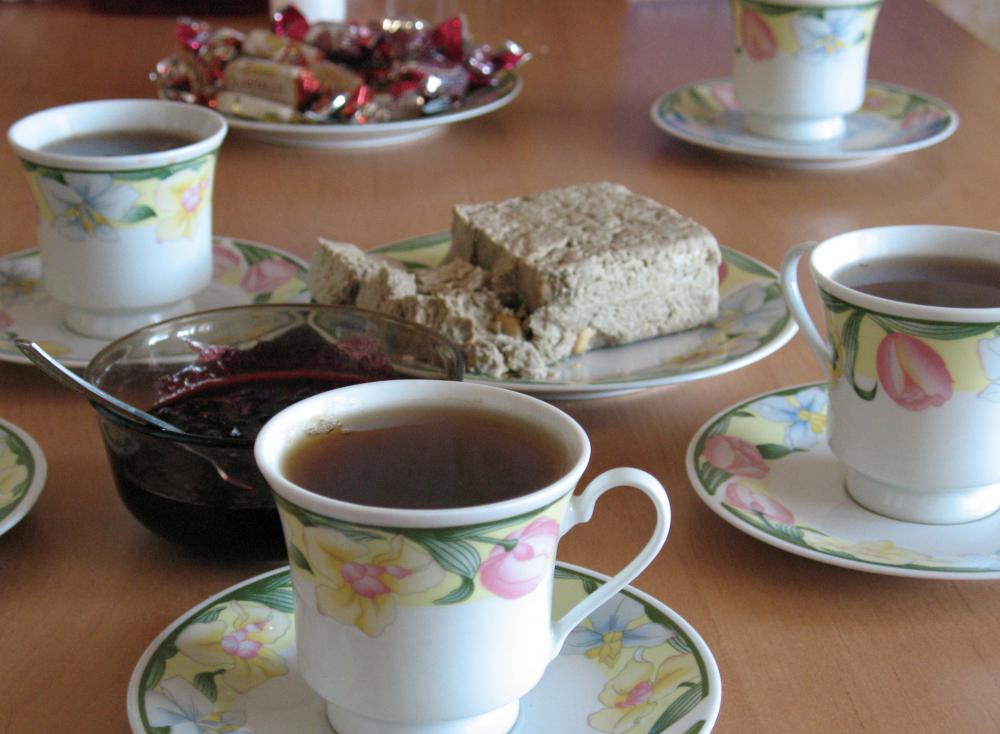At DelightedCooking, we're committed to delivering accurate, trustworthy information. Our expert-authored content is rigorously fact-checked and sourced from credible authorities. Discover how we uphold the highest standards in providing you with reliable knowledge.
What is Halva?
A common Middle Eastern dessert, halva is a sweet confection that is traditionally served with a strong coffee or tea. There are two types: one is a flour-based concoction, and the other uses finely ground nuts as its base. The texture varies greatly depending on the area from which its recipe is derived. It is often garnished with crushed pistachios or covered in chocolate. Recipes and additives vary somewhat from region to region, and from cook to cook.
The name comes from the Arabic word halawa, which means "sweet," a term that perfectly describes this concoction. Turkish and Hebrew cultures have recipes with slight variations on the Middle Eastern dessert. The inexpensive treat is eaten in small blocks and often savored, melting slowly on a person's tongue.
Halva is a quite simple and popular confection to make and takes very little time to prepare. It contains only a few basic ingredients, including water, sugar, and flour. The addition of rose water is what makes this sweet confection so unique.

The most common type of grain flour used to make halva is semolina, which is made from durum wheat. It is most often coarsely ground, as opposed to the traditional cooking flour that is finely ground. The yellow coloring of the semolina flour, also referred to as sameed, gives the treat a rich hue. While it tends to be coarse before cooking, this flour becomes soft and porridge-like when it is cooked.

This confection can also be made using nuts as a base. More crumbly in consistency, this variety is most often made by first grinding sesame seeds or sunflower seeds into a paste. Ground sesame, also known as tahini, is a common ingredient in many Persian dishes. Due to the fact that these seeds are so oily, the ground paste only needs to have a sugar syrup or honey added to it. No extra oil is necessary.
Different types of halva are found around the world. It is no longer just made in home kitchens with family recipes carried down from generation to generation. It can now be purchased in grocery stores and all kinds of candy stores.
AS FEATURED ON:
AS FEATURED ON:













Discussion Comments
@literally45-- I don't think halva is easy. The trick for making good halva is roasting the semolina perfectly in butter. You have to keep mixing the semolina on low heat to roast it. If you stop mixing, it won't roast and if you increase the heat, it will burn. It's so delicate, it definitely takes practice!
My grandmother used to call halva "the dessert for the dead." In our culture, whenever someone dies, they make halva and offer it to those who come to the house for grievances. I have no idea where this tradition came from but that's what they do.
@anon129367-- Halvah is really easy. All you have to do is cook some pine nuts in butter, followed by the semolina. Then, add sugar and milk and let it cook on low heat for ten to fifteen minutes.
This is the easiest dessert ever but it's so delicious. My mom makes this every year for Eid (Islamic holiday). Sometimes I have a craving for it and she makes it then too.
There are many different kinds of halva dishes in the Middle East. There is also different varieties of halva made in Southeast Asia.
The one I'm most familiar with is the one made from tahini. They sell this at the Middle Eastern grocery and I'm hooked on it. I love the version with pistachios in it and I eat it straight up or with some plain bread. It's really high in calories though.
Where is the recipe for Halvah?
Post your comments